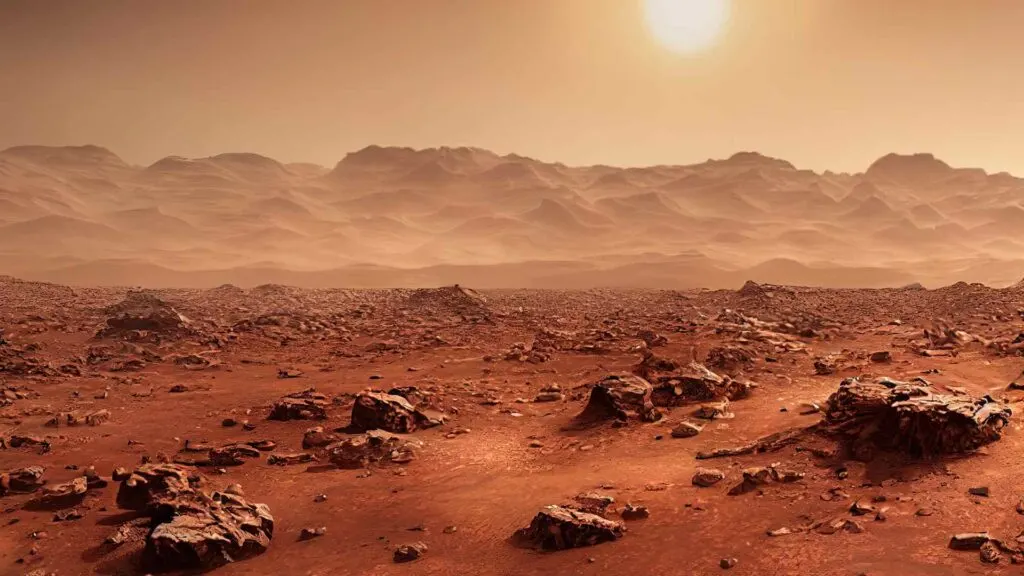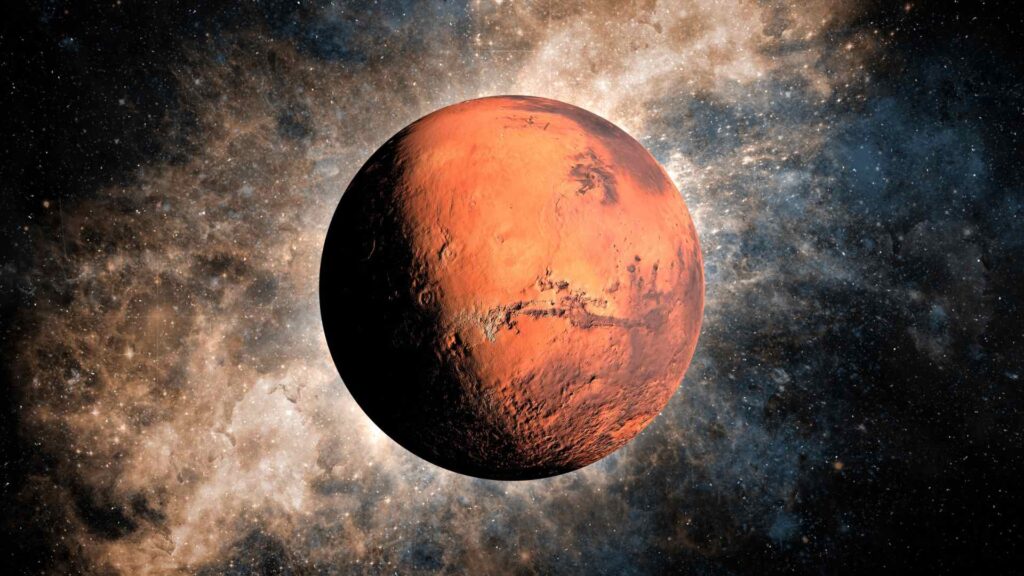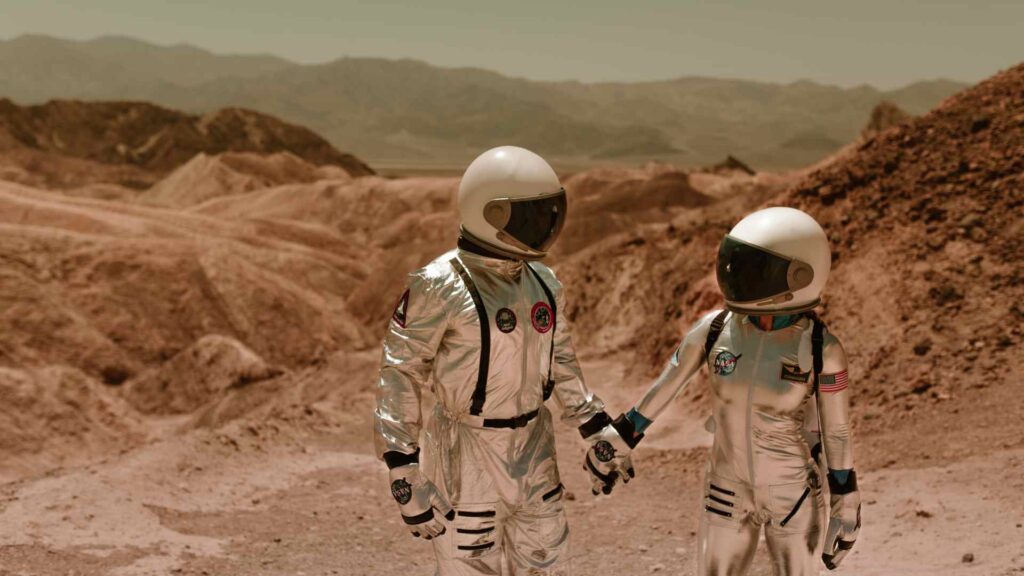Mars, the captivating Red Planet, has intrigued humanity for centuries. With its mysterious landscapes, intriguing possibilities of past life, and potential for future colonization, Mars is a world of wonders.
Let’s dive into 145 fun facts that reveal the amazing details about Mars’ atmosphere, surface, moons, history, and more.
The Red Planet’s Unique Physical Features
- Mars has the largest volcano in the solar system—Olympus Mons, which stands 13.6 miles high.
- Valles Marineris on Mars is a canyon over 2,500 miles long and up to 4 miles deep.
- Mars has a thin atmosphere, mostly made up of carbon dioxide.
- Martian sunsets are a cool blue, unlike Earth’s orange hues.
- Dust storms on Mars can last for months and sometimes cover the entire planet.
- Mars has seasons just like Earth, though they are twice as long due to its orbit.
- The average surface temperature on Mars is -81 degrees Fahrenheit.
- Gravity on Mars is about 38% of Earth’s, so a 100-pound object would weigh only 38 pounds on Mars.
- Mars has polar ice caps made of water and carbon dioxide ice.
- Mars is a desert planet with a surface area close to Earth’s landmass.
- Unlike Earth, Mars doesn’t have a magnetic field, which leaves it vulnerable to solar winds.
- Mars has regions with strong magnetic patches, remnants of an ancient magnetic field.
- The planet’s reddish color comes from iron oxide, or rust, on its surface.
- Mars’ atmosphere contains trace amounts of methane, sparking curiosity about potential life.
- Martian skies are a dusty pink during the day, unlike Earth’s clear blue.

Mars’ Orbit and Seasons
- Mars has an elliptical orbit, so its distance from the Sun varies significantly.
- The Martian year is about 687 Earth days, nearly twice as long as a year on Earth.
- Seasons on Mars vary in length due to its eccentric orbit.
- Mars’ axial tilt is 25.2 degrees, similar to Earth’s, creating distinct seasons.
- Spring on Mars is the longest season, lasting 194 days.
- Summer is the shortest season in Mars’ northern hemisphere, lasting 154 days.
- Mars’ southern hemisphere experiences more extreme temperatures than the northern.
- Winter temperatures on Mars can drop as low as -195°F near the poles.
- During winter, carbon dioxide “snow” falls on the Martian surface.
- Mars’ atmosphere is only about 1% the density of Earth’s, leading to thinner seasonal effects.
- Seasons on Mars impact its polar caps, causing them to grow and recede.
- The “Martian Sol,” or day, is about 24 hours and 39 minutes, almost like an Earth day.
- Because of its tilt, Mars has similar seasonal changes to Earth.
- The longer Martian year means plants and ecosystems would grow slower, if they existed.
- Mars experiences extreme temperature swings daily due to its thin atmosphere.

Mars’ Moons: Phobos and Deimos
- Mars has two moons: Phobos and Deimos, named after the sons of Ares in Greek mythology.
- Phobos is slowly spiraling towards Mars and may eventually collide with it.
- Deimos orbits Mars at a greater distance than Phobos and is much smaller.
- Both moons are irregularly shaped and resemble captured asteroids.
- Phobos orbits Mars three times a day, while Deimos takes over 30 hours for one orbit.
- Phobos’ surface is covered in dust and loose soil, or “regolith.”
- The Stickney Crater on Phobos spans almost half the moon’s width.
- The faint surface features of Deimos are due to a smoother surface compared to Phobos.
- Both moons have low gravity, making it challenging for spacecraft to land on them.
- Phobos’ orbit is gradually decaying, while Deimos is moving farther from Mars.
- Deimos has a smoother surface, suggesting less impact history than Phobos.
- Some scientists believe Mars’ moons could be ideal locations for space stations.
- Due to their size, Phobos and Deimos appear as tiny dots from the Martian surface.
- Phobos could disintegrate into a ring around Mars within 50 million years.
- Deimos means “panic,” while Phobos means “fear,” fitting names for Mars’ eerie moons.
Mars Exploration History
- Mars has fascinated astronomers for thousands of years, with early records dating back to ancient Egypt.
- The first successful flyby of Mars was conducted by NASA’s Mariner 4 in 1965.
- The Soviet Union’s Mars 3 was the first spacecraft to land on Mars in 1971, though contact was lost after seconds.
- NASA’s Viking missions in 1976 provided the first detailed images of the Martian surface.
- Pathfinder and its Sojourner rover marked the beginning of mobile exploration on Mars in 1997.
- The Mars Odyssey orbiter discovered vast amounts of subsurface water ice in 2002.
- NASA’s Spirit and Opportunity rovers confirmed past water activity on Mars in the early 2000s.
- Curiosity, launched in 2012, continues to study Mars’ geology and climate.
- NASA’s InSight lander, launched in 2018, studies the interior of Mars to understand its geological history.
- The Perseverance rover is currently searching for signs of ancient microbial life.
- China’s Tianwen-1 mission entered Mars orbit in 2021, and its Zhurong rover landed shortly after.
- The UAE’s Hope orbiter studies the Martian atmosphere and climate.
- More than 40 missions have targeted Mars, but less than half have been successful.
- Future missions aim to return Martian samples to Earth for study.
- The goal of Mars exploration is to pave the way for potential human missions in the 2030s.

The Potential for Life on Mars
- Mars shows signs of ancient river valleys, deltas, and lake beds, suggesting it once had liquid water.
- Some meteorites from Mars, found on Earth, contain formations that resemble microscopic life forms.
- Ancient Mars may have been warm and wet, a more life-friendly environment than it is today.
- NASA’s Curiosity rover discovered organic molecules, potential building blocks for life, on Mars.
- Seasonal methane spikes have been observed on Mars, hinting at biological or geological activity.
- Mars has areas rich in clays, which on Earth form in the presence of water.
- Some researchers believe life could survive in Martian subsurface areas, protected from radiation.
- The recurring slope lineae on Mars suggest the presence of briny water flows.
- Mars’ early atmosphere may have been thick enough to support liquid water on its surface.
- Extremophiles, organisms that survive in extreme conditions on Earth, inspire hope for life on Mars.
- Studies on Mars suggest that briny water could exist in thin layers just below the surface.
- Mars’ thin atmosphere and cold temperatures make surface life challenging but possible underground.
- No direct evidence of life has been found, but each mission contributes to the search.
- Life on Mars, if discovered, would likely be microbial and well-adapted to harsh environments.
- The search for life on Mars continues to drive scientific curiosity and exploration.
Fun Mars Puns to Make You Giggle
- Mars is out of this world, quite literally!
- You don’t have to be a “martian-al artist” to appreciate Mars.
- Mars’ mysteries are truly “spacetacular.”
- Red is the “new black” in space fashion—just ask Mars.
- What’s Mars’ favorite type of music? “Rock” and roll.
- Mars rovers never “mars” up their landing.
- Mars may be “dusty,” but it’s never “dirty.”
- Mars is always red-dy for an adventure.
- A Martian vacation might cost an “astronomical” amount.
- Mars is out of this “orbit.”
- Mars missions are a “stellar” feat of engineering.
- No weather apps for Mars—it’s mostly dust and “astromo-sphere.”
- Mars might just have the most “arresting” surface in the solar system.
- The Red Planet might be rusty, but it’s got a lot of “magnetism.”
- Get in “orbit” with Mars; it’s a magnetic experience.
- How do you know if Mars likes you? It’ll give you a “stellar” wave.
- Mars may be “single,” but it’s taken a lot of space lovers’ hearts.
- Mars is looking for someone to help “clear its atmosphere.”
- The Red Planet sure knows how to “rock” a crater.
- Mars’ humor may be “dry,” but it’s got a magnetic personality.
- NASA’s “curiosity” keeps taking Mars to new heights.
- Mars has that “gravity-defying” charm.
- Mars likes to keep a low profile—“thin atmosphere” and all.
- Mars prefers its visitors to be well-“grounded.”
- Feeling “spaced out”? Take a trip to Mars!
- Mars is a real “atmos-fear” to be reckoned with.
- Rovers “roll” with the punches on the Red Planet.
- Mars’ beauty “eclipses” all expectations.
- Don’t worry, Mars—it’s just a “phase.”
- Earth and Mars are in a “long-distance” relationship.
- Mars’ charm is “irresistible”—even without much atmosphere.
- Mars “mars”-ks the spot for adventure.
- Mars doesn’t sweat the small stuff—it’s all rocks and dust.
- Mars has a soft spot—its “craters” tell the story.
- Mars is looking for “spacers” to join its orbit.
- Martian winters are chilly, but its “heart” is warm.
- When Mars blushes, we all see red.
- The Red Planet has “space for improvement.”
- Mars and Earth have a real “pull” on each other.
- Mars likes to keep things “spacey.”
- Mars doesn’t “meteor” expectations—it exceeds them!
- Mars may have a “thin skin,” but it’s got a thick core.
- The Red Planet’s beauty is “martian-mous.”
- “Rock solid” isn’t just a phrase—it’s Mars’ identity.
- Mars doesn’t need a “makeover”—rust is its style.
- Mars is always the “center” of attention.
- Don’t let Mars’ surface fool you—it’s “grounded.”
- Mars likes to keep it “cool” at its poles.
- Life on Mars? “Perseverance” will answer that!
- Even if life isn’t there, Mars sure “rocks.”
Conclusion
Mars is full of awe-inspiring features and endless potential. With each mission, we get closer to understanding this mysterious planet and the secrets it may hold.
From quirky surface traits to possibilities of past life, Mars remains an eternal source of wonder for humanity. Keep exploring, and who knows—someday you may find yourself heading for the Red Planet!
